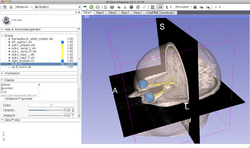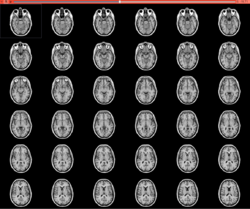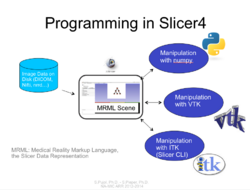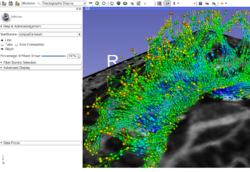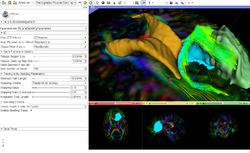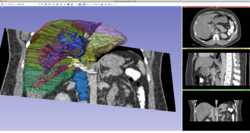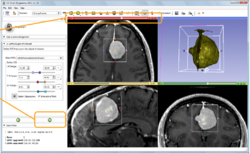Home < Documentation < Nightly < Training
Introduction: Slicer Nightly Tutorials
- This page contains "How to" tutorials with matched sample data sets. They demonstrate how to use the 3D Slicer environment (version Nightly release) to accomplish certain tasks.
- For tutorials for other versions of Slicer, please visit the Slicer training portal.
- For "reference manual" style documentation, please visit the Slicer Nightly documentation page
- For questions related to the Slicer4 Compendium, please send an e-mail to Sonia Pujol, Ph.D
|
Some of these tutorials are based on older releases of 3D Slicer. The concepts are still useful but bear in mind that some interface elements and features will be different in updated versions.
|
General Introduction
Slicer Welcome Tutorial
- The SlicerWelcome tutorial is an introduction to Slicer based on the Welcome module.
- Author: Sonia Pujol, Ph.D.
- Audience: First time users who want a general introduction to the software.
- Based on: 3D Slicer version 4.0
|
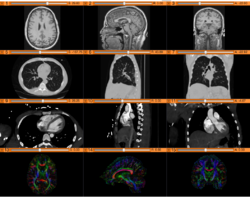
|
Slicer4Minute Tutorial
- The Slicer4Minute tutorial is a brief introduction to the advanced 3D visualization capabilities of Slicer 4.0.
- Author: Sonia Pujol, Ph.D.
- Audience: First time users who want to discover Slicer in 4 minutes.
- Based on: 3D Slicer version 4.0
- The Slicer4Minute dataset contains an MR scan of the brain and 3D reconstructions of the anatomy
|
|
Slicer4 Data Loading and 3D Visualization
Tutorials for software developers
Slicer4 Programming Tutorial
Specific functions
Slicer4 Diffusion Tensor Imaging Tutorial
- The Diffusion Tensor Imaging Tutorial course guides through the basics of loading Diffusion Weighted images in Slicer, estimating tensors and generating fiber tracts.
- Author: Sonia Pujol, Ph.D.
- Audience: End-users and developers
- The DTI dataset contains an MR Diffusion Weighted Imaging scan of the brain.
|
|
Slicer4 Neurosurgical Planning Tutorial
Slicer4 3D Visualization of DICOM images for Radiology Applications
- The Slicer4RSNA course guides through 3D data loading and visualization of DICOM images for Radiology Applications in Slicer4.
- Author: Sonia Pujol, Ph.D., Kitt Shaffer, M.D., Ph.D.
- Audience: Radiologists and users of Slicer who need a more comprehensive overview over Slicer4 visualization capabilities.
- The Slicer4RSNAdataset1 and Slicer4RSNAdataset2 contain a series of MR and CT scans, and 3D models of the brain, lung and liver.
|
|
Slicer4 Quantitative Imaging tutorial
- The Slicer4 Quantitative Imaging tutorial guides through the use for Slicer for quantifying small volumetric changes in slow-growing tumors, and for calculating Standardized Uptake Value (SUV) from PET/CT data.
- Authors: Jeffrey Yap, Ph.D., Ron Kikinis, M.D., Randy Gollub, M.D., Ph.D., Wendy Plesniak, Ph.D., Nicole Aucoin, B.Sc., Sonia Pujol, Ph.D., Valerie Humblet, Ph.D., Andriy Fedorov, Ph.D., Kilian Poh, Ph.D., Ender Konugolu, Ph.D.
- Audience: Radiologists and users of Slicer who need a more comprehensive overview over Slicer4 quantitative imaging capabilities.
- The PETCTFusion and Change Tracker datasets contain a series of MR, CT and PET data.
|
|
Summer 2012 Tutorial contest (under construction)
Automatic Left Atrial Scar Segmenter
Qualitative and quantitative comparison of two RT dose distributions
Dose accumulation for adaptive radiation therapy
WebGL Export
- WebdGLExport
- Authors: Nicolas Rannou, Daniel Haehn, Children's Hospital
|
|
OpenIGTLink
Additional resources
- This Slicer 4.1 webinar presents the new features and improvements of the release, and a brief overview of work for the next release.
- Authors: Steve Pieper Ph.D.
- Audience: First time users and developers interested in Slicer 4.1 new features.
- Length: 0h20m
|
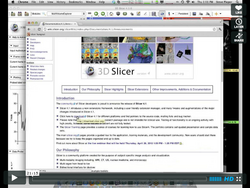
|
- This Intro to Slicer 4.0 webinar provides an introduction to 3DSlicer, and demonstrates core functionalities such as loading, visualizing and saving data. Basic processing tools, including manual registration, manual segmentation and tractography tools are also highlighted. This webinar is a general overview. For in depth information see the modules above and the documentation pages.
- Authors: Julien Finet, M.S., Steve Pieper, Ph.D., Jean-Christophe Fillion-Robin, M.S.
- Audience: First time users interested in a broad overview of Slicer’s features and tools.
- Length: 1h20m
|
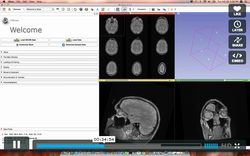
|
- The Slicer Registration Case Library provides many real-life example cases of using the Slicer registration tools. They include the dataset and step-by-step instructions to follow and try yourself.
- Author: Dominik Meier, Ph.D.
- Audience: users interested learning/applying Slicer image registration technology
|
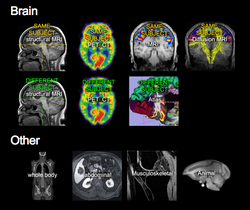
|
External Resources
Using the Editor
This set of tutorials about the use of slicer in paleontology is very well written and provides step-by-step instructions. Even though it covers slicer version 3.4, many of the concepts and techniques have applicability to the new version and to any 3D imaging field:
Team Contributions
See the collection of videos on the Kitware vimeo album.
User Contributions
See the User Contributions Page for more content.




